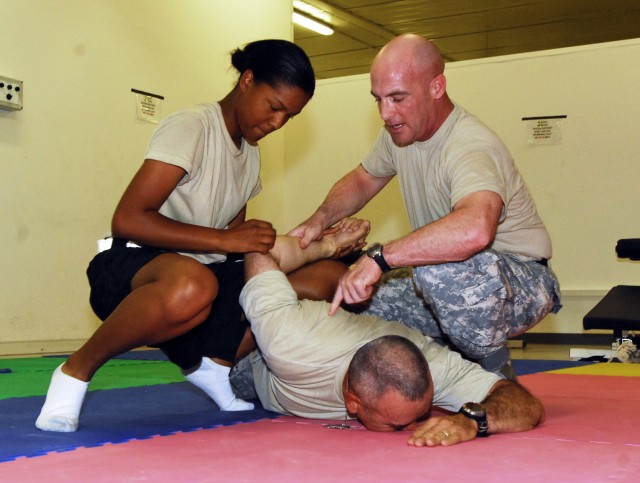BASRA, Iraq (Army News Service, Aug. 11, 2009) -- "You're not fighting in the UFC...you're not there to stick around and fight," said Sgt. 1st Class Erin James, a brigade provost sergeant teaching the Multi-National Division-South self-defense class.
The goal of this class is to teach self-defense as part of the MND-S sexual assault prevention and response program so servicemembers are better able to defend themselves, said James, who is part of the 2nd Brigade Combat Team, 4th Infantry Division.
James has taught unarmed self-defense since 1991. 1st Lt. Ronald Jarvi, a third-degree black belt in Americanized Tae Kwon Do, has been teaching for eight years. They hold the hour-and-a-half class at the morale, welfare and recreation gym four days a week.
Divided into two instruction blocks, the class begins with James' lessons in mechanical advantage control holds. MACH is new to the Armed Forces as part of the nonlethal weapons course instructor's curriculum.
"My portion of the class is initial contact and hopefully to put the guy down and make him think twice about messing with you -- the element of surprise," said James. "So many times you have to be able to use the element of surprise. I tell my students that the element of surprise is ideal for them because you have that petite Soldier who comes up against a guy larger than her so it takes the element of surprise...mechanical advantage control holds and pain compliance to escape the situation."
James said he doesn't train students to stick around and fight, rather he focuses on training them to immobilize their assailant long enough to get away. He said that goes for anybody whether they're 6'2" or 4'2" -- they have to be able to move against an attacker and get out.
The second portion of the class is divided into four progressive parts based on skill level. The first part is the basics of striking and blocking a punch from a stand-still position.
"My style of martial arts is more stand-up fighting, so there's no grappling or rolling around on the ground," said 1st Lt. Jarvi, MND-S personnel strength manager. "I do a lot of blocking for punch defenses and grab defenses."
The second, third and fourth part of the classes are going to be more developed around frontal grab defenses, punch defenses and grab defenses from the rear.
"Depending on how the interest is, I can go into more containment and joint manipulation and things like that," said Jarvi. "There's a lot of potential for it. It just depends on how involved the Soldiers get and if it's something they want to push."
According to James, it's important to teach multiple techniques that allow Soldiers to rotate through the possibilities as the situation dictates.
Jarvi recommends Soldiers attend the classes on a regular basis for the training to be of benefit particularly to those people seen as "soft targets."
"Repetition is really the key," he said. "I don't expect Soldiers to be able to go to one class and then they can defend themselves. A lot of this stuff does take time to get that muscle memory because a lot of these movements aren't things that they've done before.
He also encourages working outside the class as well.
"It's important that they attend multiple classes and they work on it with fellow Soldiers or they practice it on the side, on their own," he said. "But that's really the key. It becomes part of their routine to walk through a couple of grab defenses. When and if they ever had to they would be able to bring back that muscle memory for a punch or grab defense."
(Sgt. Debralee P. Crankshaw serves with Multi-National Division-South Public Affairs.)






Social Sharing